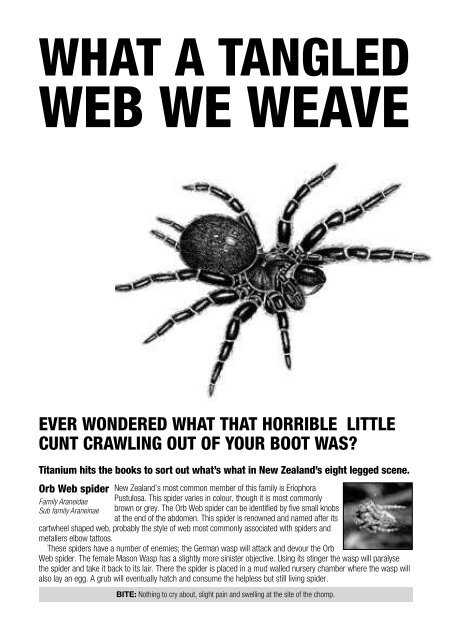The best coffee in town (possibly) - foxymoron
The best coffee in town (possibly) - foxymoron
The best coffee in town (possibly) - foxymoron
You also want an ePaper? Increase the reach of your titles
YUMPU automatically turns print PDFs into web optimized ePapers that Google loves.
WHAT A TANGLED<br />
WEB WE WEAVE<br />
Black cobweb<br />
Steatoda capensis<br />
<strong>The</strong>se spiders are a sh<strong>in</strong>y black to dark brown and are a similar size<br />
and shape to the Katipo, some <strong>in</strong>dividuals may have a fa<strong>in</strong>t red stripe on<br />
the back of the abdomen. <strong>The</strong>se characteristics often lead to a case of<br />
mistaken identity with the Katipo, they can be dist<strong>in</strong>guished by the smaller size of any red stripe<br />
and the absence of a red hourglass mark<strong>in</strong>g on the under side of the abdomen. <strong>The</strong>se spiders<br />
are generally considered to have come to New Zealand from South Africa. <strong>The</strong> Black cobweb<br />
spider is common around homes and is often found <strong>in</strong> similar habitats to that of the katipo. In<br />
some parts of the country Steatoda seems to have displaced the Katipo from its beach habitat,<br />
it is not known whether this is a direct result of competition between the two species or whether it is a result of<br />
environmental changes due to human <strong>in</strong>tervention.<br />
BITE: While resembl<strong>in</strong>g the Katipo <strong>in</strong> a number of ways it does not share its nasty reputation, <strong>in</strong> short it’s a B<br />
grade South African Katipo try hard.<br />
White Tailed<br />
Spiders<br />
Lampona cyl<strong>in</strong>drata and<br />
Lampona mur<strong>in</strong>a<br />
Another Australian import White tail spiders were first recorded <strong>in</strong> New<br />
Zealand <strong>in</strong> 1886, at Waiwera. Typically greyish <strong>in</strong> colour with banded<br />
legs the spider gets its name from the dist<strong>in</strong>ctive white mark<strong>in</strong>g on the<br />
end of the abdomen. <strong>The</strong> leg-span of a fully grown spider is around 4<br />
centimetres. <strong>The</strong>re are two different species of White Tail <strong>in</strong> NZ, Lampona<br />
mur<strong>in</strong>a has been here for over a hundred years and more recently Lampona cyl<strong>in</strong>drata was<br />
discovered <strong>in</strong> the South Island around the early eighties. <strong>The</strong>se night stalkers are unusual <strong>in</strong> that<br />
they only hunt other spiders. Instead of build<strong>in</strong>g a web the White Tail cautiously enters the web<br />
of its <strong>in</strong>tended victim and proceeds to mimic the struggles of a trapped <strong>in</strong>sect by tugg<strong>in</strong>g at web strands. <strong>The</strong> resident<br />
spider is fooled <strong>in</strong>to <strong>in</strong>vestigat<strong>in</strong>g the disturbance where it f<strong>in</strong>ds itself lunch; for the White Tail that is (horrible little cunts)!<br />
BITE: In recent times the white tail has usurped the Katipo as New Zealand’s number 1 bad bugger, however<br />
evidence to back this reputation up is questionable. <strong>The</strong>re has been a lot of media hysteria surround<strong>in</strong>g particularly<br />
nasty white tail maul<strong>in</strong>gs and bites are often attributed to these spiders even when the culprit was never seen.<br />
Where these spiders have been positively identified as caus<strong>in</strong>g a bite the symptoms are usually local pa<strong>in</strong> and<br />
swell<strong>in</strong>g around the bite area. <strong>The</strong> bite can develop <strong>in</strong>to a small ulcerous wound due to a necrotis<strong>in</strong>g agent <strong>in</strong> their<br />
venom (sounds pretty fucken gruesome to me mate). Such wounds usually clear up with<strong>in</strong> a week. Like Bee st<strong>in</strong>gs<br />
everyone will react differently, so of corse you could be the unlucky exception that does die a horrible, agonis<strong>in</strong>g<br />
death at the hands of one of these little fuckers, but it’s highly unlikely. Just squash the cunt, you’re about a<br />
million times bigger than it!<br />
EVER WONDERED WHAT THAT HORRIBLE LITTLE<br />
CUNT CRAWLING OUT OF YOUR BOOT WAS?<br />
Titanium hits the books to sort out what’s what <strong>in</strong> New Zealand’s eight legged scene.<br />
Orb Web spider<br />
Family Araneidae<br />
Sub family Arane<strong>in</strong>ae<br />
New Zealand’s most common member of this family is Eriophora<br />
Pustulosa. This spider varies <strong>in</strong> colour, though it is most commonly<br />
brown or grey. <strong>The</strong> Orb Web spider can be identified by five small knobs<br />
at the end of the abdomen. This spider is renowned and named after its<br />
cartwheel shaped web, probably the style of web most commonly associated with spiders and<br />
metallers elbow tattoos.<br />
<strong>The</strong>se spiders have a number of enemies; the German wasp will attack and devour the Orb<br />
Web spider. <strong>The</strong> female Mason Wasp has a slightly more s<strong>in</strong>ister objective. Us<strong>in</strong>g its st<strong>in</strong>ger the wasp will paralyse<br />
the spider and take it back to its lair. <strong>The</strong>re the spider is placed <strong>in</strong> a mud walled nursery chamber where the wasp will<br />
also lay an egg. A grub will eventually hatch and consume the helpless but still liv<strong>in</strong>g spider.<br />
BITE: Noth<strong>in</strong>g to cry about, slight pa<strong>in</strong> and swell<strong>in</strong>g at the site of the chomp.<br />
Black Tunnel<br />
Web spider<br />
Porrhothele Antipodiana<br />
One of New Zealand’s more impressive spiders, the Tunnel Web is a<br />
large, stocky look<strong>in</strong>g beast. Generally these spiders have a dark<br />
abdomen and legs and a leathery brown cephalothorax (fused head and<br />
thorax). <strong>The</strong>se spiders have pronounced sp<strong>in</strong>nerets that look like two<br />
feelers stick<strong>in</strong>g out of the arse end of the spider.<br />
Common throughout most of New Zealand, the Tunnel Web is often found under rocks and<br />
logs where they build a tunnel-like web with a broad funnel open<strong>in</strong>g. This open<strong>in</strong>g is designed<br />
to alert the spider to any potential d<strong>in</strong>ner guest that would typically <strong>in</strong>clude beetles and other<br />
ground dwell<strong>in</strong>g <strong>in</strong>sects. <strong>The</strong>re are apparently accounts of these spiders captur<strong>in</strong>g snails and even mice(you must be<br />
fucken jok<strong>in</strong>g)!<br />
<strong>The</strong> female of the species is larger and stronger than the male and as with most spiders, gett<strong>in</strong>g a fuck can be a<br />
serious gamble. <strong>The</strong> male must enter the web of his prospective mate where he may be attacked and eaten. If the<br />
male manages to get close enough he endeavours to grasp the female with his front legs. If he is successful the<br />
female becomes docile, he gets busy, then attempts to get the fuck out of there before he becomes a post coital<br />
snack. However, some of the males of the species are a little, no make that a lot more devious. <strong>The</strong>re have been<br />
recorded <strong>in</strong>cidences where once the female becomes docile, <strong>in</strong>stead of mak<strong>in</strong>g out the male proceeds to kill and eat<br />
her. What a tangled web we weave.<br />
BITE: <strong>The</strong>se twisted cunts have very large fangs and can give a nasty bite. Symptoms are described as mild and<br />
likened to a bee st<strong>in</strong>g.



